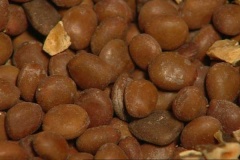Difference between revisions of "Carob Beans"
(→Description) |
|||
| Line 1: | Line 1: | ||
{{Infobox_Seeds | {{Infobox_Seeds | ||
| − | | image = | + | | image = Carob_Beans-1.jpg |
| origin = - | | origin = - | ||
| stowage factor = - | | stowage factor = - | ||
| Line 9: | Line 9: | ||
| risk factors = - | | risk factors = - | ||
}} | }} | ||
| + | __TOC__ | ||
==Description== | ==Description== | ||
A bean shipped in bulk from the eastern Mediterranean. | A bean shipped in bulk from the eastern Mediterranean. | ||
<br><br> | <br><br> | ||
| − | Carob, dried or roasted and having a slightly sweet taste, in powder or chip form, is used as an ingredient in cakes and cookies. Carob is sometimes used as a substitute for | + | Carob, dried or roasted and having a slightly sweet taste, in powder or chip form, is used as an ingredient in cakes and cookies. Carob is sometimes used as a substitute for chocolate. The [[seeds]], also known as locust [[beans]], are used as animal feed. They are also the source of locust bean gum, a thickening agent used in numerous processed foods. In Egypt, carobs are consumed as a snack. <br><br>Crushed pods are used to make a refreshing drink. Compotes and liqueurs are made from carob in Turkey, Malta, Portugal, Spain and Sicily. Carob has proven effective in relieving diarrhea in infants. In Libya, a syrup extracted from carob named rub is used as a complement to an Asida meal.The so-called carob syrup made in Peru is actually from the [[fruit]] of the Prosopis nigra tree. |
<br><br> | <br><br> | ||
Carob has also been used as a non-toxic alternative to chocolate in dog treats, as the theobromine in chocolate is fatally toxic to all [[animals]], even humans in high enough doses (in raw form). | Carob has also been used as a non-toxic alternative to chocolate in dog treats, as the theobromine in chocolate is fatally toxic to all [[animals]], even humans in high enough doses (in raw form). | ||
Revision as of 13:56, 31 October 2012
| Infobox on Carob Beans | |
|---|---|
| Example of Carob Beans |  |
| Facts | |
| Origin | - |
| Stowage factor (in m3/t) | - |
| Angle of repose | - |
| Humidity / moisture | - |
| Oil content | - |
| Ventilation | - |
| Risk factors | - |
Carob Beans
Contents
Description
A bean shipped in bulk from the eastern Mediterranean.
Carob, dried or roasted and having a slightly sweet taste, in powder or chip form, is used as an ingredient in cakes and cookies. Carob is sometimes used as a substitute for chocolate. The seeds, also known as locust beans, are used as animal feed. They are also the source of locust bean gum, a thickening agent used in numerous processed foods. In Egypt, carobs are consumed as a snack.
Crushed pods are used to make a refreshing drink. Compotes and liqueurs are made from carob in Turkey, Malta, Portugal, Spain and Sicily. Carob has proven effective in relieving diarrhea in infants. In Libya, a syrup extracted from carob named rub is used as a complement to an Asida meal.The so-called carob syrup made in Peru is actually from the fruit of the Prosopis nigra tree.
Carob has also been used as a non-toxic alternative to chocolate in dog treats, as the theobromine in chocolate is fatally toxic to all animals, even humans in high enough doses (in raw form).
If well dried before shipment will generally withstand climatic changes. If damaged through wetting may be unfit for extraction of juice. Seriously damaged beans may be utilized in the manufacture of alcohol and as a pig food. Beans of an old crop are liable to develop weevil. Liable to heat, require careful ventilation.
Full information on this product is in the process of completion.











